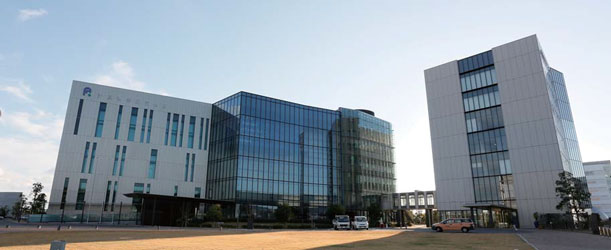 |
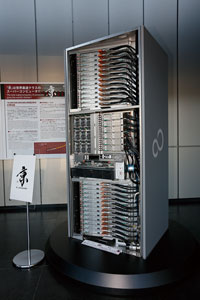 |
| Advanced Computational Science and Research Center (right) was established adjacent to RIKEN Advanced Institute for Computational Science (AICS) in April 2011 |
Supercomputer "K computer" |
Supercomputers are used to operatee normous amount of computation for academic
researches and industrial uses with super-high-speed. In particular, the
"K computer", a supercomputer installed in Kobe city by RIKEN,
the Institute of Physical and Chemical Research, attained 10 petaflops
(arithmetic capacity of 10 quadrillion operations per second), which it
is named after. It boasts of high performance of the highest level in the
world, rated as the 1st in June and November 2011 consecutively by "TOP500",
which ranks the world highperformance supercomputers periodically.
Our user we introduce in this issue is Kobe city. We focus in particular on Kobe Enterprise Promotion Bureau (KEPB), Kobe Cit y Government . Promoting Kobe Medical Industry Development Project, KEPB has been spreading simulation using supercomputer and industrial promotion through this. With these as the background, KEPB also invites enterprises, universities and international conferences making the most of advantage of location.
In Kobe city, initially a section in charge of urban planning adopted our
three - dimensional (3D) real time VR "UC-win/ Road." It has
been showing its full effect in visualization for explaining urban plans
to different parties involved. Based on the data used in those opportunities,
currently another section (Planning and Coordination Bureau) is making
an attempt to visualize the future plan of water front of Kobe.
On the other hand, taking our proposal as an opportunity, Kobe Enterprise
Promotion Bureau took part in "Build Live Kobe 2011" sp onsored
by Inter nat ional Alliance for Interoperability Japan Association, an
event to work on an architectural project within a limit time using BIM
(Building Information Modeling), as a subject matter. They experienced
scenes of using advanced simulation in the field of architecture.
Later, KEPB exhibited jointly in SC (Supercomputing Conference) 12 (2012),
an international conference on supercomputers, and SC 13 (2013) with some
bodies including us. Also in "SIGGRAPH ASIS 2013."an inter nat
ional event on CG held in Hong Kong, FORUM8 cooperated with KEPB in its
booth in its activity of inviting "SIGGRAPH ASIA 2015" to be
held in Kobe. In each case, presentations were made using 3D VR of Kobe
cit y created with UC-win/Road as examples of simulation using "K
Computer".
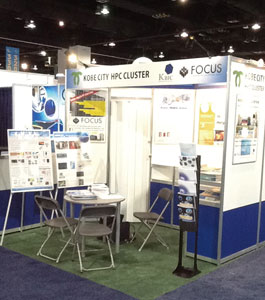 |
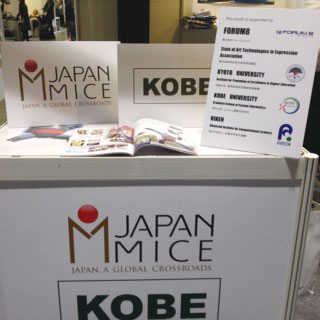 |
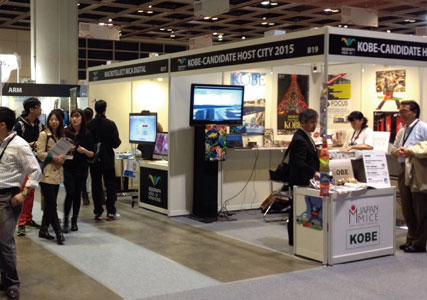 |
|
| Kobe City Booth in "SC13" |
Kobe City Booth in "SIGGRAPH ASIA 2013" | ||
| Urban Strategy with Emphasis on Design, New City Administration Drawing Attention |
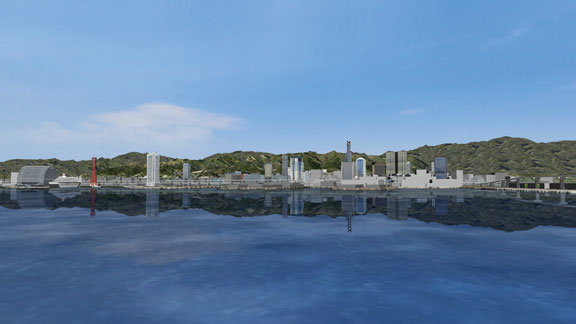 |
|
| VR Data in creating landscape typical of Kobe with ocean and Rokko mountain views received "the 9th 3D-VR Contest (2010) Honorable Judge's Award, Design Award" (FORUM8) |
Surrounded by mountains and sea, Kobe city has historical and exotic cityscape with modern urban space in harmony, attracting many tourists. Various urban strategies have been attempted to maintain and utilize "things unique to Kobe".
In the meantime, suddenly in 1995, the city was seriously damaged by the
Great Hanshin Awaji Earthquake that occurred in the area. In addition,
there were great changes in the situations society and economy in Japan.
Kobe city was under the pressure of transforming its urban strategy in
order to expand as an attractive city as before.
As one of its solutions, Kobe city worked on the creative city strategy,
"City of Design KOBE", formulated in 20 07. This aims at building
a community of continued residence, a community to be visited, and a community
of sustainable development. It is positioned as a city where all citizens
create new attractions with designs through "collaboration and participation"
making the best use of the city's advantages. In specific, the city holds
up a vision of reconsidering and enhancing "things Unique to Kobe"
in 3 basic policies: community designs, daily life designs, and business
designs, from five design perspectives: enrich lifestyles, use the City's
uniqueness and attractions, revitalize the economy, enhance creativity,
and develop people's spirits for the next generation.
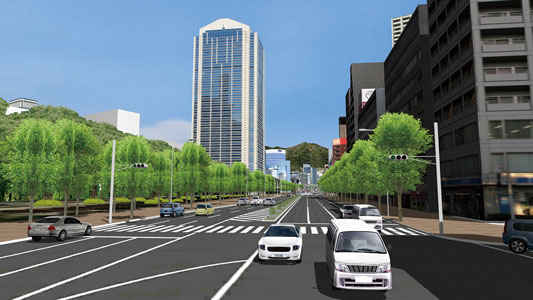 |
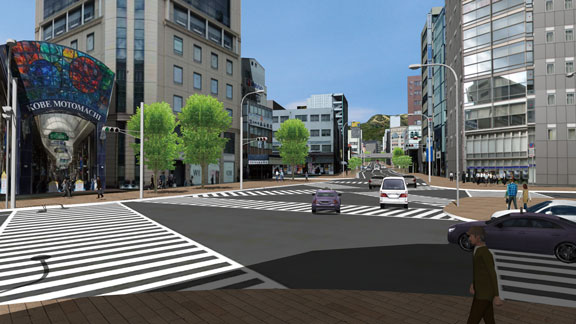 |
Such efforts of the Kobe city led to certification as "The design
city" of "creative city network" by UNESCO.
On the other hand, in Kobe city, Mr. Kizo Hisamoto took office as new Mayer,
taking over Mr. Tatsuo Yada, previous Mayer who had been taking office
for as long as 12 years for 3 terms.
In his administrative policy the new Mayor developed his ideas about town
planning from a wide range of viewpoints including this "City of Design
KOBE". As part of this, he mentioned promotion of Kobe Medical Industry
Development and industrial use of "K Computer". He states his
idea of aiming to activate local economy with science and technology such
as cutting-edge medical practice and the supercomputer in concert with
these national projects as its core.
Regarding this , Mr. Taisuke Matsuzaki, Group Manager of Supercomputer
& University Group, Kobe Enterprise Promotion Bureau thinks that the
former mayor put emphasis on restoration from the damage of Great Hanshin
Awaji Earthquake, but that the administrative policy of the new mayor suggests
his intention of moving a step forward for new growth, while following
the former policies basically.
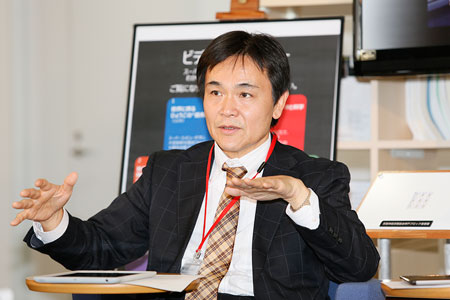 |
| Mr. Taisuke Matsuzaki, Group Manager, Supercomputer & University Group |
| Working Both for the City and FOCUS, KEPB Supports Industries with the Supercomputer |
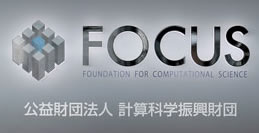 |
Mr. Taisuke Matsuda, who also works as Senior Associate for industrial use promotion of FOCUS, looks back the established of Kobe Enterprise Promotion Bureau in aiming to deal wi t h challenges such as how to realize industrial restoration from the Great Hanshin Awaji Earthquake or how to start new industries.
It's been 19 years since the Great Earthquake. In the process, it was required to switch to a new industrial structure. In addition , star ting in 1998 , Kobe Medical Industry Development has been developing into a national project to aim at becoming a central point of advanced medical technologies and the related industries , mainly during the 2nd stage of Port Island, an artificial island in Kobe city.
Also in 2007, following the decision that "K computer" would be located in Port Island in Kobe city, the Enterprise Promotion Bureau paid attention to industrial activation through Kobe Medical Industry Development and the supercomputer. In particular, they invited companies and universities able to enjoy advantages of large-scale simulation technology or high performance computing (HPC) based on the supercomputer. Through their results, KEPB had an aim to lead to improvement of related fields not only in Kobe but also in the whole nation.
In 2008, FOCUS (a public utility foundation since April 2013) was founded within the prefecture's government facilities as a foundation financed by Hyogo prefecture, Kobe city, and Kobe Chambers of Commerce and Industries in order to contribute to promotion of the computational science field and development of industries and economy using "K computer". On completion of Advanced Computational Science and Research Center in 2011, FOCUS moved into the Institute. Service of "FOCUS supercomputer" for industrial use started in April 2011.
Also in 2010, RIKEN established RIKEN Advanced Institute for Computational Science (AICS) as a service facility for "K computer". Service of "K computer" started in September 2012. Along with this, a system for promoting industrial use of the supercomputer in cooperation with FOCUS, AICS, Research Organization for Information Science & Technology (RIST) that is an agent for promoting use of the registered facilities of "K computer", HPCI Consortium that is the supercomputer user community, Integrated Research Center of Kobe Universit y, or Graduate School of Simulat ion Studies , University of Hyogo.
FOCUS is currently active with 3 business areas: 1) Promotion of industrial use of "K Computer", 2) Support for advancing technologies using FOCUS supercomputers, revitalization of industries with dissemination of simulation technology through opening a simulation school etc., 3) Dissemination and education such as holding seminars and exhibition at trade shows or presentation of case studies of using supercomputers.
In the meantime, partly because of having a common t arget of "p romot ing use of supercomputers" in restoration of the local industries and invitation of enterprises, Mr. Matsuzaki and others have been working with two kinds of business cards, both for Kobe city and FOCUS as mentioned above, since April 2013.
"Being in operation more than a year, 'K computer' has brought about results in various fields such as life science, manufacturing, space engineering, or nanoscience. In order for those cut tingedge research results to be handed down to industries to develop new technologies, it is our task to propose simulation and analysis (using supercomputers), and support companies so that they can create original products and become healthy."
| Diverse Ways of Using VR, Cooperation with FORUM8 Evaluated |
Reflecting high awareness concerning urban design, City Planning General
Office of Kobe city quickly introduced UC-win/Road several years ago. The
areas around civic center section and the eastern commercial district were
represented with 3D VR. The data created were utilized, for example, for
explanation of urban planning to the council and local residents.
Besides, Planning and Coordination Bureau adopted UC-win/Road for redevelopment
based on the grand design "Port City Kobe" formulated in 2011.
An attempt has been made to visualize the future of the waterfront reflecting
the grand design.
It was "Build Live Kobe 2011" mentioned at the opening that Kobe
Enterprise Promotion Bureau got involved directly with FORUM8. In response
to our proposal, Kobe city supported a competition to design an assignment
on the Internet using BIM tool. An assignment was given to design a building
suitable "City of Design KOBE", with the facility site of Port
Island owned by the city set as the subject site. Mr. Tomoharu Kamiki,
Manager of Supercomputer & University Group of the same Bureau (Associate
for industrial use promotion of FOCUS) realized usefulness of BIM. He says
he was convinced of the possibility of utilizing it for public facilities.
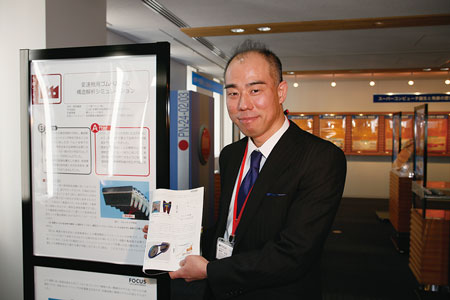 |
| Mr. Yomoharu Kamiki |
On the other hand, Kobe city took part in the exhibition of the world's greatest events on supercomputers also mentioned above, SC12 (November 2012 in Utah, USA) and SC13 (November 2013, in Colorado, USA) together with us FORUM8, the local enterprise invited by the city, universities, and research institutes. Since it was the first time for local governments to exhibit in the exhibition in the former, and also the only exhibitor as a local government in the latter, the exhibit attracted at tention from in and outside the nation at both events. In addition, it became an effective incentive for enterprises to expand into Kobe.
In particular, regarding 3D VR of the civic center section of Kobe created with UC-win/Road, the effect of high-speed rendering with a supercomputer was easy to understand. It seems visitors were much interested in it.
Moreover, Kobe city exhibited at "SIGGRAPH ASIA 2013," an event on CG and interactive technologies (held in Hong Kong in November 2013) aided by Tourism Agency of the Ministry of Land, Infrastructure and Transport (MLIT). The city made efforts in inviting "SIGGRAPH ASIA 2015" to the city and promoting the science contents owned by the city.
Also in these activities, 3D VR presentation of the areas around the site proposed for the venue contributed effectively to promotion of the city.
| Towards Wider Dissemination of Simulation |
|
"We are inviting enterprises into Kobe city, and our main pur p ose
is for Japanese industries to become stronger by utilizing simulation technology
(based on supercomputers)." |
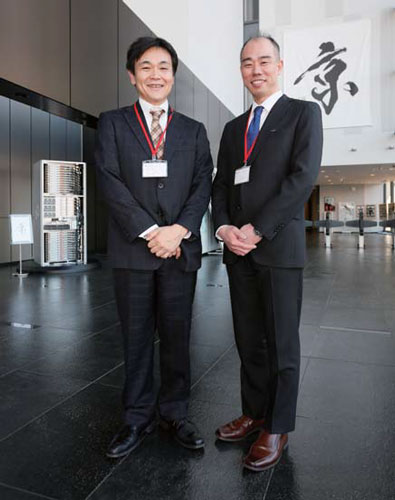 |
(Reported and written by Takashi Ikeno)